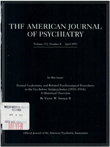Interleukin-1 beta: a putative mediator of HPA axis hyperactivity in major depression?
Abstract
OBJECTIVE: There is extensive evidence that major depression, and particularly melancholia, is characterized by hypothalamic-pituitary- adrenal (HPA) axis hyperactivity as well as systemic immune activation, which may be accompanied by increased interleukin-1 beta production. Interleukin-1 beta is known to enhance HPA axis activity during an immune response. This study investigated whether interleukin-1 beta production is related to HPA axis activity in depressed subjects. METHOD: The subjects were 28 inpatients with major or minor depression and 10 normal comparison subjects. The authors measured 1) the subjects' cortisol levels after an overnight 1-mg dexamethasone suppression test (DST) and 2) mitogen-stimulated supernatant interleukin-1 beta production by peripheral blood mononuclear cells. RESULTS: Statistically significant positive correlations between interleukin-1 beta production and post-DST cortisol values were found in the study group as a whole and in the depressed and normal subgroups separately. CONCLUSIONS: It is suggested that constituents of the immune response (such as interleukin-1 beta) in major depression may contribute to HPA axis hyperfunction in that illness.
Access content
To read the fulltext, please use one of the options below to sign in or purchase access.- Personal login
- Institutional Login
- Sign in via OpenAthens
- Register for access
-
Please login/register if you wish to pair your device and check access availability.
Not a subscriber?
PsychiatryOnline subscription options offer access to the DSM-5 library, books, journals, CME, and patient resources. This all-in-one virtual library provides psychiatrists and mental health professionals with key resources for diagnosis, treatment, research, and professional development.
Need more help? PsychiatryOnline Customer Service may be reached by emailing [email protected] or by calling 800-368-5777 (in the U.S.) or 703-907-7322 (outside the U.S.).



